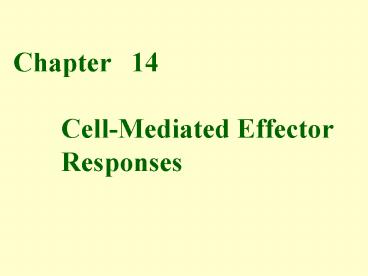Cell-Mediated Effector - PowerPoint PPT Presentation
1 / 51
Title:
Cell-Mediated Effector
Description:
Effector cells that mediate delayed-type hypersensitivity (DTH) ... NKR-P1 (a C-type lectin recognizing carbohydrates) Inhibitory Receptors: CD94/NKG2 ... – PowerPoint PPT presentation
Number of Views:219
Avg rating:3.0/5.0
Title: Cell-Mediated Effector
1
Chapter 14 Cell-Mediated Effector
Responses
2
Cell-mediated immunity Detect and eliminate
cells that harbor intracellular
pathogens. Ag-specific cells CD4 T cells,
CD8 T cells Ag-nonspecific cells NK cells
macrophages
neutrophils
eosinophils
3
Cytotoxic T Cells
4
- Two major categories of cell-mediated immune
responses - Effector cells that have direct cytotoxic
activity. - Effector cells that mediate delayed-type
- hypersensitivity (DTH) reactions
5
Three types of effector T cells 1. CD4
TH1cells 2. CD4 TH2 cells 3. CD8 CTLs
Characteristics - less stringent activation
requirements - increased expression of
cell-adhesion molecules - production of both
membrane-bound and soluble effector molecules
6
- The CD45RO isoform associates with the TCR
complex and - CD4/CD8 much better than does the CD45RA
isoform. - - CD2 LFA-3, LFA-1 ICAMs
7
- - The FasL, perforins, and granzymes mediate
target cell destruction by the CTLs. - - Membrane-bound TNFb and soluble IFNg and
GM-CSF promote macrophage - activation by the TH1 cell.
- The membrane-bound CD40L and soluble IL-4,
IL-5, IL-6, and IL-10 play a role - in B cell activation by the TH2 cell.
8
Generation of Effector CTLs
B7
CD28
9
Naïve CTL-Ps Need Help from TH1 Cells to
provide IL-2
paracrine
10
Memory CTL-Ps Appear to Secrete Sufficient IL-2
to Stimulate Their Own Proliferation and
Differentiation into Effector CTLs
autocrine
11
Tumor-Cell Destruction by a CTL
CTL
tumor cell
12
CTL-Mediated Killing of Target Cells
perforin monomers granzyme proteases
13
Cell-Mediated Pore Formation in Target-Cell
Membrane
fusion
release
iCa?
insertion
14
Perforin Pore on a Red Blood Cell
- Perforin exhibits sequence
- homology with C9, and the
- pores formed by perforin are
- similar to those observed in
- complement-mediated lysis.
- The perforin pores facilitate
- entry of granzyme proteases
- into the cell.
- Granzymes activate an apop-
- totic pathway within the cell.
15
CTL Can Use Fas to Lyze a Target Cell
16
CTL-mediated Killing Depends on Perforin, Fas,
or A Combination of the Two
17
CTL-Mediated Apoptotic Pathways
Caspase cysteine, aspartate protease
18
Natural Killer Cells
19
- Natural Killer (NK) Cells
- 5 - 10 of the recirculating lymphocyte
population - No immunization is required. No memory
- a population of large granular lymphocytes
- constitutively cytotoxic, always having large
granules - - involved in the defense against viruses and
tumors - Activity is stimulated by IFNa, IFNb, and IL-12.
- express CD16 (FcgRIII)
- do not express TCR/CD3
- Recognition is not MHC-restricted.
- normal in RAG-1, RAG-2, and SCID mice
- Cytotoxicity depends on perforin and granzymes.
20
Time Course of Viral Infection
21
NK-Cell Receptors Activation Receptors
NKR-P1 (a C-type lectin recognizing
carbohydrates) Inhibitory Receptors
CD94/NKG2 (recognizing HLA-E with an HLA
peptide) KIR (gt 50 members specific for
one or a limited number of
polymorphic products of particular HLA loci)
22
Opposing-signals Model of NK Activity
KIR killing inhibitory receptor
AR activation receptor
23
Ab-Dependent Cell-Mediated Cytotoxicity (ADCC)
24
Experimental Assessment of Cell-mediated
Cytotoxicity Mixed Lymphocyte Reaction
(MLR) Cell-mediated Lympholysis (CML) Graft
versus Host Reaction (GVHR)
25
Mixed Lymphocyte Reaction (MLR)
26
Cell-Mediated Lympholysis (CML)
27
Delayed-Type Hypersensitivity
28
Overview of the Delayed Type Hypersensitivity
(DTH) Response
29
(No Transcript)
30
Formation of Granuloma
31
Role of IFNg in Host Defense against
Intracellular Pathogens
32
(No Transcript)
33
Survival of the Intracellular Pathogen
34
Chapter 15 Leukocyte Migration
and Inflammation
35
Lymphocyte Recirculation Routes
36
General Structures of the 4 Families of
Cell-Adhesion Molecules (CAM)
37
Cell Adhesion Molecules (CAM)
38
Four Sequential but overlapping Steps in
Neutrophil Extravasation
39
Cell-Adhesion Molecules and Chemokines Involved
in the 1st 3 Steps of Neutrophil extravasation
40
(No Transcript)
41
A Lymph-Node Postcapillary Venule with High
Endothelium
42
Numerous Lymphocytes Bound to the Surface of a
High Endothelial Venule (HEV)
43
Naïve T Cells Tend to Home to Secondary Lympoid
Tissues through Their HEV Regions
44
Effector T Cells Expressing Particular Homing
Receptors Will Home to particular Tertiary
Extralymphoid Tissues
45
Extravasation of a Naïve T Cell through a High
Endothelial Venule into a Lymph Node
46
- Mediators of Inflammation
- Chemokines
- 2. Plasma Enzyme Mediators
- kinin system
- clotting system
- fibrinolytic system
- complement system
- 3. Lipid Inflammatory Mediators
- 4. Cytokine Inflammatory mediators
47
(No Transcript)
48
Tissue Damage Induces Formation of Plasma Enzyme
Mediators by the Kinin System, the Clotting
System, and the Fibrinolytic System
49
The Breakdown of Membrane Phospholipids
Generates Mediators of Inflammation
50
(proinflammatory cytokines)
51
Overview of the Cells and Mediators Involved in
a Local Acute Inflammatory Response
52
Overview of the Organs and Mediators Involved in
a Systemic Acute-Phase Response
53
The End































